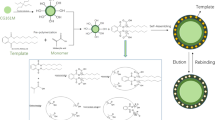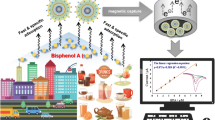Abstract
The use of plastic bags in the long-term contact with food may cause certain harm to human health due to the production process of plastic bags and the use of plasticizers such as BPA. Therefore, the analysis and research methods of BPA and other harmful substances are receiving extensive attention. Molecularly imprinted polymers have attracted much attention for their high selectivity, while magnetic metal–organic frameworks (MOFs) have been widely used for their excellent adsorption potential. However, the current methods of synthesizing these polymers typically require many steps and are time-consuming. Additionally, these methods involve the use of large amounts of solvents, which are not environmentally friendly and sustainable. This study proposed an easy, convenient, quick, and green method for synthesizing magnetic copper MOF molecularly imprinted polymers (MCMMIPs) using a one-pot technique to overcome these challenges. The resulting MCMMIPs exhibited excellent magnetic separation ability (20 emu/g), a large specific surface area (289.4 m2/g), and a well-defined imprinted cavity. MCMMIPs have been successfully applied to the extraction of BPA in plastic bags with a detection limit of 1.01 µg/kg and recoveries ranging from 72.1% to 102.85%. More importantly, the detection method proposed based on the material has been successfully applied to the detection of BPA in plastic bags, with a good detection effect.









Similar content being viewed by others
Data availability
The datasets analyzed during the study are available from the corresponding author upon reasonable request.
References
vom Saal FS, Vandenberg LN (2021) Endocrinology 162:171. https://doi.org/10.1210/endocr/bqaa171
Xiao C, Wang L, Zhou Q, Huang X (2020) J Hazard Mater 384:121488. https://doi.org/10.1016/j.jhazmat.2019.121488
Hercog K, Maisanaba S, Filipic M, Sollner-Dolenc M, Kac L, Zegura B (2019) Sci Total Environ 687:267–276. https://doi.org/10.1016/j.scitotenv.2019.05.486
Gayrard V, Lacroix MZ, Grandin FC, Collet SH, Mila H, Viguie C, Gely CA, Rabozzi B, Bouchard M, Leandri R, Toutain PL, Picard-Hagen N (2019) Environ Health Perspect 127:77005. https://doi.org/10.1289/EHP4599
Moreman J, Lee O, Trznadel M, David A, Kudoh T, Tyler CR (2017) Environ Sci Technol 51:12796–12805. https://doi.org/10.1021/acs.est.7b03283
Huang M, Liu S, Fu L, Jiang X, Yang M (2020) Chemosphere 253:126707. https://doi.org/10.1016/j.chemosphere.2020.126707
Kim S, Lee I, Lim JE, Lee A, Moon HB, Park J, Choi K (2020) Sci Total Environ 744:140856. https://doi.org/10.1016/j.scitotenv.2020.140856
Zhu M, Li Y, Niu Y, Li J, Qin Z (2020) Environ Pollut 263:114443. https://doi.org/10.1016/j.envpol.2020.114443
Zhang C, Tao T, Yuan W, Zhang L, Zhang X, Yao J, Zhang Y, Lu H (2017) Anal Chem 89:4566–4572. https://doi.org/10.1021/acs.analchem.6b05071
Mei M, Huang X, Luo Q, Yuan D (2016) Anal Chem 88:1900–1907. https://doi.org/10.1021/acs.analchem.5b04328
Saraji M, Shahvar A (2017) Anal Chim Acta 973:51–58. https://doi.org/10.1016/j.aca.2017.04.029
Hamidi S, Taghvimi A, Mazouchi N (2021) Crit Rev Anal Chem 51:103–114. https://doi.org/10.1080/10408347.2019.1684235
Campos CDM, Gamage SST, Jackson JM, Witek MA, Park DS, Murphy MC, Godwin AK, Soper SA (2018) Lab Chip 18:3459–3470. https://doi.org/10.1039/c8lc00716k
Alidoust M, Yamini Y, Baharfar M, Seidi S, Rasouli F (2021) Talanta 224:121864. https://doi.org/10.1016/j.talanta.2020.121864
Plotka-Wasylka J, Marc M, Szczepanska N, Namiesnik J (2017) Crit Rev Anal Chem 47:373–383. https://doi.org/10.1080/10408347.2017.1298987
Arul P, Huang ST, Gowthaman NSK, Mani G, Jeromiyas N, Shankar S, John SA (2021) Anal Chim Acta 1150:338228. https://doi.org/10.1016/j.aca.2021.338228
Luo Z, Chen H, Wu S, Yang C, Cheng J (2019) Chemosphere 237:124493. https://doi.org/10.1016/j.chemosphere.2019.124493
Huang X, Huang D, Chen J, Ye R, Lin Q, Chen S (2020) Anal Bioanal Chem 412:849–860. https://doi.org/10.1007/s00216-019-02282-3
Zhu C, Liu F, Ling C, Jiang H, Wu H, Li A (2019) Appl Catal B 242:238–248. https://doi.org/10.1016/j.apcatb.2018.09.088
Yang S, Qiu X, Jin P, Dzakpasu M, Wang XC, Zhang Q, Zhang L, Yang L, Ding D, Wang W, Wu K (2018) Chem Eng J 353:329–339. https://doi.org/10.1016/j.cej.2018.07.105
Liu C, Sun ZC, Pei WY, Yang J, Xu HL, Zhang JP, Ma JF (2021) Inorg Chem 60:12049–12058. https://doi.org/10.1021/acs.inorgchem.1c01253
Yang H, Wang B, Liu J-H, Cheng J, Yu L, Yu J, Wang P, Li J-R, Su X (2020) Sens Actuators B: Chem 314:128048. https://doi.org/10.1016/j.snb.2020.128048
Ahsan MA, Jabbari V, Islam MT, Turley RS, Dominguez N, Kim H, Castro E, Hernandez-Viezcas JA, Curry ML, Lopez J, Gardea-Torresdey JL, Noveron JC (2019) Sci Total Environ 673:306–317. https://doi.org/10.1016/j.scitotenv.2019.03.219
Jiang H-L, Fu Q-B, Wang M-L, Lin J-M, Zhao R-S (2021) Food Chem 345:128841. https://doi.org/10.1016/j.foodchem.2020.128841
Wang X, Deng C (2015) Talanta 144:1329–1335. https://doi.org/10.1016/j.talanta.2015.08.014
Huang Y, Li Y, Luo Q, Huang X (2021) ACS Appl Mater Interfaces 13:37280–37288. https://doi.org/10.1021/acsami.1c11433
Zhou T, Wang Y, Li T, Li H, Yang C, Sun D, Wang D, Liu C, Che G (2021) Chem Eng J 420:129904. https://doi.org/10.1016/j.cej.2021.129904
Zeng L, Cui H, Chao J, Huang K, Wang X, Zhou Y, Jing T (2020) Mikrochim Acta 187:142. https://doi.org/10.1007/s00604-020-4119-9
Asfaram A, Ghaedi M, Dashtian K (2017) Ultrason Sonochem 34:640–650. https://doi.org/10.1016/j.ultsonch.2016.06.018
Bagheri N, Khataee A, Habibi B, Hassanzadeh J (2018) Talanta 179:710–718. https://doi.org/10.1016/j.talanta.2017.12.009
Mohammadnejad M, Fakhrefatemi M (2021) J Mol Struct 1224:129041. https://doi.org/10.1016/j.molstruc.2020.129041
Rajendran J, Kannan TS, Dhanasekaran LS, Murugan P, Atchudan R, Alothman ZA, Ouladsmane M, Sundramoorthy AK (2022) Chemosphere 287:132106. https://doi.org/10.1016/j.chemosphere.2021.132106
Cao XL, Popovic S (2018) Food Addit Contam Part A Chem Anal Control Expo Risk Assess 35:49–55. https://doi.org/10.1080/19440049.2017.1382730
Acknowledgements
This study was financially supported by Hunan Provincial Natural Science Foundation of China (No. 2023JJ60146).
Funding
The authors are grateful to Hunan Provincial Natural Science Foundation of China via a project: No. 2023JJ60146.
Author information
Authors and Affiliations
Contributions
Binbin Zhou and Ming Zhong conceived the project. Yongbo Zhu wrote the manuscript. Yongbo Zhu and Meng Liang performed the UV-Vis, XRD, FTIR, SEM, VSM, TGA, BET assays and data analyses. Zuokun Zhang, Lijun Huang and Meng Liang completed the adsorption experiment.
Corresponding authors
Ethics declarations
Conflict of interest
All authors declare that they have no known competing financial interests or personal relationships that could have appeared to influence the work reported in this paper.
Additional information
Publisher's Note
Springer Nature remains neutral with regard to jurisdictional claims in published maps and institutional affiliations.
Rights and permissions
Springer Nature or its licensor (e.g. a society or other partner) holds exclusive rights to this article under a publishing agreement with the author(s) or other rightsholder(s); author self-archiving of the accepted manuscript version of this article is solely governed by the terms of such publishing agreement and applicable law.
About this article
Cite this article
Zhu, Y., Liang, M., Liu, Y. et al. Magnetic Metal–Organic Framework Material Synthesized by Molecular Imprinting Technology for Analysis of Bisphenol A. Chromatographia 86, 669–676 (2023). https://doi.org/10.1007/s10337-023-04277-w
Received:
Revised:
Accepted:
Published:
Issue Date:
DOI: https://doi.org/10.1007/s10337-023-04277-w




